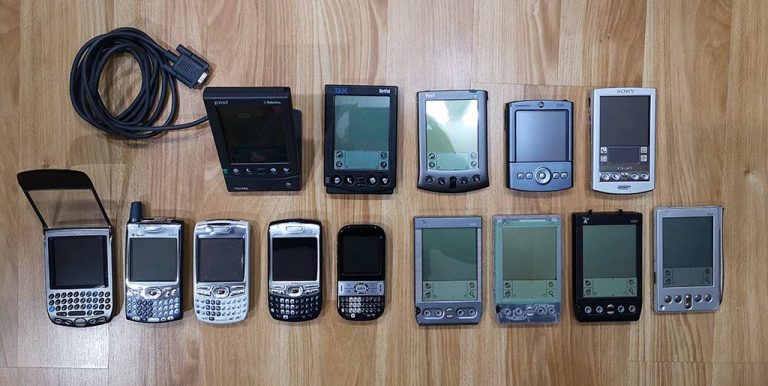Some failures are inevitable. A large number of companies no longer exist because they failed to innovate, could not adapt to the changing market trends, made some questionable leadership decisions etc.
You can pre-book our free e-book containing case studies of over 50 companies’ failures.
Palm Inc, a pioneering company in the early smartphone market, was known for its PalmPilot and later the Palm Treo smartphones. A number of factors led to the slow death of the brand.
In this article, we will explore the reasons that led to the downfall of Plam Long Inc.
Why Palm Inc went out of business?
1. Changing trends and customer preferences
We covered the story of how Borders went out of business because it couldn’t recognize the changing customer demands. Something similar happened to Palm as well.
Since the early 2000s, PDA(personal digital assistants) sales have been declining due to the steady rise of more user-friendly and trendy smartphones.
Palm’s competitor, the iPhone, has altered everything since its inception.
In the world of smartphone enthusiasts, Apple’s Macworld keynote was an extremely innovative device. As a consequence, Palm’s devices became less appealing to consumers.
The company struggled to compete against devices such as the iPhone and ultimately fell behind the rapid pace of innovation in the smartphone market.
In 2005, three firms dominated the smartphone industry: Palm, Research-In-Motion (maker of the Blackberry), and Nokia.
However, as time passed, consumer preferences shifted toward more user-friendly devices, which Palm was unable to recognize.
2. Failure to compete
The company tried to keep going for a while. The Treo was Palm Inc.’s first smartphone, and it had a tiny screen with a physical keypad attached to it.
After the company acquired permanent authorization to create, modify, and market Palm OS Garnet, Centro was released in 2007.
However, its popularity was short-lived due to the introduction of the iPhone into the market, which radically altered the mobile industry.
By the September 2007 quarter, Palm’s Treo sales had only increased to 689,000, while Blackberry sales reached nearly 3.2 million and the newly introduced Apple iPhone sold more than a million units.
Palm failed to follow up on its success in the mobile organizer market.
Analysts pointed out that the company was slow to recognize that customers wanted wireless voice and data from the same device.
According to ZDNet, “Palm just couldn’t find the formula for over-the-air synchronization with Microsoft Outlook, which business users demand and RIM nailed with its BlackBerry device.”
3. Product quality issues
Apart from being run over by the innovations of competitors, Palm also experienced numerous product delays.
In late 2009, the business released updated versions of its hardware, the Pre. Palm positioned the Pre as a high-end smartphone and charged a high price for it.
However, Pre’s features failed to attract consumers. Pre’s hardware keyboard, which some believed could have been a big selling point against the iPhone, was particularly poor.
Additionally, The Pixi was a particularly poor successor to the Pre. When people were getting familiar with the Palm Pre, the business rushed for their new mobile, Pixi.
The Pixi was intended as a less expensive, more compact Pre with a keypad. Perhaps Palm was attempting to recapture some of the magic it had with the Palm Centro, which was well-liked by ladies.
However, it further confused users and complicate its thin, fragile developer platform. The business attempted to make the plastic keyboard a more prominent feature, but it failed to attract customers.
4. Failure to innovate
Furthermore, Palm did not have a device comparable to the iPod touch.
Apple’s iPod touch is a significant component of the iPhone platform’s success.
This is because it is inexpensive, fun for kids to play with, distributed through different channels than phones, and does not require a wireless contract.
Since Palm’s legacy is building PDAs without cell phone access, it was a logical choice to create something like this. But the company failed to innovate such type of product.
About Palm Inc:
Palm Inc. is an American company headquartered in Sunnyvale, California, and was founded in 1992. Palm developed both a portable wireless device and an operating system for portable hardware devices and desktop computers. The firm created the first WebOS versions, the first operating system used in smartphones, personal digital assistants (PDAs), GPS devices, and handheld gaming systems.
Palm Inc. was best known for developing and producing the Palm Pilot, one of the first commercially successful personal digital assistants (PDAs). In the late 1990s, the Palm Pilot was widely popular and set the standard for mobile devices in the technology market. The Palm Pilot took just 18 months to sell one million units. By late 2001, the company generated $1.6 billion in revenue.
Lessons from the Downfall of Palm Inc.
In 2008, Palm was acquired by HP for $1.2 billion. According to Todd Bradley, Executive Vice President and President of the Personal Systems Group of HP, “Quite frankly we made the decision to acquire Palm to accelerate our growth in the hyper-growing smartphone market.”
Bradley also stated, “Let’s be crystal clear: Microsoft continues to be a huge strategic partner for HP.
As we look at webOS though, it’s a natural platform for us to develop products on.
Collectively, the lack of innovation, intense competition, software limitations, marketing challenges, and not adapting to the changing customer needs ultimately led to the downfall of Palm Inc.
An idea management tool can assist you in avoiding such mistakes and staying ahead of the competition. Learn how to choose an idea capture software that can help you achieve an innovation culture in your organization.



